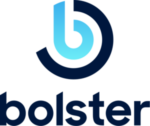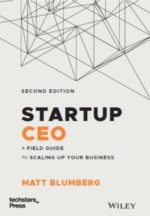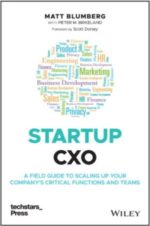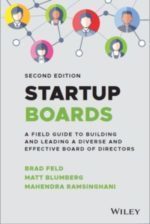I’m thrilled to announce that we created mini-books (about 80 pages long and only $9-10 on Amazon) out of five of the major functional areas covered in Startup CXO: A Field Guide to Scaling Up Your Company’s Critical Functions and Teams, part of our series along with Startup CEO: A Field Guide to Scaling Up Your Business and Startup Boards: A Field Guide to Building and Leading an Effective Board of Directors. I’ve always said that while I love all three books, in some ways Startup CXO is the best because it’s a “book of books.” While I’d still encourage all CEOs and senior executives (CXOs) to read the full manuscript, my friends and co-authors and I are happy to…
Category
Human Resources
Why Executive Searches are So Slow, and What You Can Do About That as a Candidate
It’s been a big break between posts – as many of you probably know, I moved to Board Chair and left the CEO role at Bolster last summer (it’s now in the very capable hands of my friend and co-founder Cathy Hawley), and I’m now CEO of a super cool AI company called Acrolinx. So yes, that means I went through a job search – and I found my ultimate job as a result of an inbound cold email from a headhunter! The rich irony in that as someone who founded an executive search platform is not lost on me. So when a good friend of mine who is also between CEO gigs and looking at several opportunities asked me…
Decisions
Happy Leap Day! One of the better books I’ve read in the last 6 months is James Clear’s Atomic Habits: An Easy & Proven Way to Build Good Habits & Break Bad Ones, which provides a great framework around habits. It’s worth a read, whether you’re talking about business habits/routines or personal ones. This isn’t a book review, but quickly while I have you – here’s a summary of his “laws”: HOW TO CREATE A GOOD HABITThe 1st Law: Make It ObviousThe 2nd Law:Make It AttractiveThe 3rd Law: Make It EasyThe 4th Law: Make It Satisfying HOW TO BREAK A BAD HABITInversion of the 1st Law: Make It InvisibleInversion of the 2nd Law: Make It UnattractiveInversion of the 3rd Law:…
Fighting Confirmation Bias
I was mentoring a first time founder the other day who asked me, “How do you know what advice to follow and what advice not to follow?” (For the record, it’s a little ”meta” to answer that question!). I talked about looking for patterns and common themes in the advice from others and exercising judgment about how to pick and choose from competing pieces of advice. But then he asked me how I fight confirmation bias when I’m exercising judgment and incoming advice. Fighting confirmation bias is both incredibly important and incredibly difficult, and I’d never articulated my thoughts on that before, so I thought I’d do that here. The way you have to train yourself to fight confirmation bias…
Camera On, Mic On
At my last company, we used to occasionally attend a giant meeting at one of the large ISPs — Microsoft, Yahoo, and the like — and it always annoyed me to be presenting to or engaging in a discussion with a room full of a dozen people and having all of them there with their laptops open, clearly distracted and doing other work. I’m increasingly finding annoyance with the Zoom equivalent, which is being in a meeting or attending a presentation, but turning off your mic and camera. It’s impossible to know as the person leading the meeting or speaking if you’re actually there. And if you’re there, if you’re paying attention. And how many times in a meeting can…
Should CEOs wade into Politics, Part III (From Tim Porthouse)
I’ve gotten to know a number of Bolster members over the last few years, and one who I have come to appreciate quite a bit is Tim Porthouse. I’m on Tim’s email list, and with his permission, I’m reprinting something he wrote in his newsletter this month on the topic of CEO engagement in politics and current events. As you may know, I’ve written a bunch on this topic lately, with two posts with the same title as this one, Should CEOs wade into Politics (part I here, part II here). Thanks to Tim for having such an articulate framework on this important subject. Your Leadership Game: “No Comment.” Should you speak up about news events/ politics? Most of the time,…
Measure Twice, Cut Once
The old carpenter’s axiom of being extra careful to plan before executing is something not enough executives take to heart in business. Just like cutting a piece of wood a little too long, sometimes you execute in ways that can be modified on the fly; but other times, just like the cases where you cut a piece of wood too short, you can’t. And of course, in business, sometimes it’s somewhere in between. Some examples: It’s an interesting question as to whether or not this axiom conflicts with the startup mentality of moving quickly and with agility. I don’t think it does, although in the startup ecosystem, a lot of fixed decisioning has moved to variable, which means you may…
Chief People Officer Pitfall for Later Stage CEOs
(This is a bonus quick 5th post, inspired by long time StartupCEO.com reader Daniel Clough, to the series that ended last week about Scaling CPO’s- the other posts are: When to Hire your First Chief People Officer, What does Great Look like in a Chief Privacy Officer, Signs your Chief Privacy Officer isn’t Scaling, and How I Engage With The Chief People Officer.) As I’ve noted over the years, the Chief People Officer role is a tough one to get right and a tough one to scale with the organization if what you’re really looking for is a strategic business partner who can lead not just the important blocking and tackling in HR but innovates the people part of your…
How I Engage With The Chief People Officer
Post 4 of 4 in the series of Scaling CPO’s- the other posts are, When to Hire your First Chief People Officer, What does Great Look like in a Chief Privacy Officer and Signs your Chief Privacy Officer isn’t Scaling. You won’t have a ton of time to engage with the Chief People Officer but there are a few ways where I’ve typically spent the most time, or gotten the most value out or my interactions with them. So, you’ll need to capitalize during those few moments when you do get a chance to engage with the Chief People Officer. I ALWAYS work with the CPO as a direct report. No matter who my HR leader is, no matter how…
Signs Your Chief People Officer Isn’t Scaling
This is the third post in the series. The first one When to hire your first CPO is here and What does Great Look Like in a CPO is here) If you’ve been following my previous blog posts on the Chief People Officer you have figured out when to hire one and what to look for in getting a great one but even so, you can’t just assume that your Chief People Officer is going to be able to scale with your company. I have found that Chief People Officers who aren’t scaling well past the startup stage are the ones who typically operate in the following ways. First, a CPO might not be able to scale if they are…
Onboarding Executives
I wrote a colorfully-named post years ago called Onboarding vs. Waterboarding, which detailed out some of the general principles around onboarding new employees that our companies have used over the years. A few weeks back, one of our clients and fellow CEOs of a Series C Ed:Tech company asked me for tips on onboarding senior executives, and some of what I said varied from or built on that earlier post. Here are a few of the themes we riffed on: Special thanks to my friend Amir for inspiring this post!



